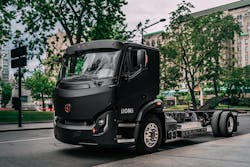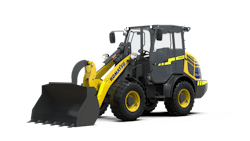On November 17, U.S. President Joe Biden signed the Global Memorandum of Understanding (Global MOU) on Zero-Emission Medium- and Heavy-Duty Vehicles during COP27 — a global conference bringing together government heads and elected leaders as well as industry to discuss climate action — endorsing the shift toward zero-emission transportation solutions.
The Global MOU signifies a commitment from the countries which have signed and endorsed it to work together to achieve 100% zero-emission new truck and bus sales by 2040. An interim goal of 30% zero-emission vehicle sales by 2030 has been set as part of this, with the overall goal of reaching net-zero carbon emissions by 2050.
In addition to the 26 countries which to date have signed the Global MOU, several sub-national governments, businesses and other global organizations related to the transportation industry have endorsed it. These include vehicle OEMs such as BAE Systems, Nikola, Scania and several others as well as suppliers like Eaton and ABB. Fleet owners and operators and utility and infrastructure providers have also endorsed it, helping demonstrate the transportation industry's commitment to achieving the MOU's goals.
Why Create an MOU?
Diesel-powered heavy transport vehicles like buses and delivery trucks are vital to society but are also large contributors to greenhouse gas emissions (GHG). As such, it has become imperative to find ways to reduce emissions from these vehicles. Many manufacturers and other organizations are of course working on this; several vehicle manufacturers have introduced battery-electric vehicles and hydrogen is seen as the more feasible alternative to diesel for larger vehicles with long driving ranges.
READ MORE from our colleagues at Machine Design: The Case for the Hydrogen Economy
The Global MOU was first introduced at COP26 and initially signed by 16 countries. More countries, businesses and organizations have signed it since then. Besides the United States, other countries which signed on during COP27 include Ukraine, Ireland, the Dominican Republic and more.
Co-led by the clean vehicles nonprofit CALSTART's Drive to Zero program and the Netherlands, the Global MOU aims to utilize real-world data on currently available vehicle models and technology readiness to help set achievable goals for the transportation industry's shift to zero-emissions.
According to CALSTART, there are now over 800 zero-emission medium- and heavy-duty vehicles (MHDV) available in the market globally. While it was once considered difficult to create diesel alternatives in this space, technology advancements in recent years, particularly for batteries, have enabled huge advancements.
Of course there is still work to be done and challenges to be overcome, but by bringing world leaders and companies together to reduce global emissions there is a better chance that collective investment and development can help achieve desired goals.
The climate has been an important policy area for President Biden, with several initiatives already announced by his administration and the Dept. of Energy (DOE) including funding for electric vehicles and charging in the infrastructure bill. Prior to his signing of the Global MOU, a group of 16 U.S. lawmakers signed a bicameral letter urging the President to sign the MOU and commit the country to its goals.
Not only does working toward the MOU's targets help to reduce emissions, but also offers opportunities for investment in the U.S. economy. New manufacturing and jobs will likely be created while also providing the country with a means to reduce dependence on foreign oil.
"As an original signer, we recognize the Global MOU's significance and are ready to collaborate with our policy partner group, CALSTART, and other global organizations to focus on decarbonization," said Nate A. Baguio, Senior Vice President of Commercial Development at Lion Electric, a manufacturer of zero-emission heavy-duty vehicles, in the company's press release voicing support for President Biden signing the MOU. "Transitioning toward ZE-MHDVs will foster job growth in the clean energy sector, develop new, global sales opportunities for the MHDV industry and support the implementation of both the Inflation Reduction Act and the Infrastructure Law."
How the MOU Could Impact Fluid Power
The push toward zero-emission vehicles will of course impact component manufacturers of all types, including those in the fluid power and other motion control industries — and a key reason for the rebranding of our publication at the beginning of 2022.
Electrification, the main method to date being utilized to achieve zero emissions, is changing how systems and overall vehicles are designed in many cases. Although some may worry alternatives to diesel will cause a replacement of traditional hydraulics and pneumatics, that is not the case.
Instead, it is providing opportunities to rethink how fluid power systems can be designed. There could be some instances where these systems are replaced, as was the case when Moog and Komatsu developed an all-electric wheel loader, but in many heavier duty mobile applications the power provided by hydraulics will still be necessary.
The latter was the case for Danfoss when it developed a proof-of-concept electric wheel loader. As Kimmo Rauma, vice president of Danfoss' Editron division, explained during an interview with Power & Motion, the company was able to rethink the design of the hydraulics system which enabled efficiency improvements to be achieved.
Sun Hydraulics, a brand of Helios Technologies, recently introduced a cartridge valve capable of converting hydraulic flow to electrical energy. This technology and other advancements like it demonstrate there is still a place for fluid power and opportunities to modernize it in order to achieve component, system and overall vehicle efficiency gains which can also aid with lowering emissions.
As many in the industry have stated in recent years, it is an exciting time for the fluid power industry due to the technology advancements and opportunities possible as the mobile and other industries work towards a reduction in global emissions.
We want to hear from you!
What impacts are you seeing from the push to zero-emission vehicles? What new technologies have you seen enter the market? What are some of the biggest challenges you are facing or foresee with this transition?
Let us know! Email me at [email protected] or reach out to us on social media.
Twitter: @TechnlgyEditor or @PowerMotionTech
LinkedIn: @PowerMotionTech




